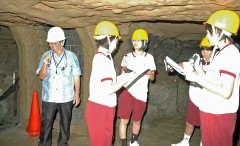Haebaru Junior High School students learn about the ravages of war in order to become peace tour guides.

On June 14, at Kyan in Haebaru Town, students of Haebaru Junior High School explain what occurred in a cave where many wounded soldiers were brought during the war.
June 15, 2011 Ryukyu Shimpo
Twenty-four Haebaru Junior High School third-grade students have qualified as peace guides for battlefield tours of Okinawa.
As practice, on June 21 they are scheduled to guide first grade boys and girls from their own school through the Haebaru Imperial Japanese Army Hospital Cave. The previous week, on June 14, they rehearsed their guide-commentary in the No. 20 Cave, which is open to the public.
According to a staff member of the Haebaru Cultural Center, training for junior high school students as guides is a rare initiative within the prefecture.
The peace tour study for boys and girls of this age is the brainchild of 38 year-old social studies teacher Takashi Miyara who wanted his students to know about the ravages of war in their own area. The Peace Guides Group and the Culture Center also cooperated in the initiative. From May 10 this year the students have spent time learning about the lead-up to the Battle of Okinawa in six sessions of two lessons each, and have taken part in a study tour around notable battle sites in the town.
In order to become qualified to guide visitors around the battle sites they need to have these lessons, to attend a workshop of the Center and to register with the Haebaru Peace Guides Group. Miyara recommends his students to do this as the first step in a general study program, hoping that the boys and girls will grow up aware of the ravages of war through their experience telling people about the Battle of Okinawa.
The students practiced their commentary in No. 20 Cave, explaining the situation during the war, pointing at wooden posts burned by blasts from the flamethrowers used by U.S. soldiers, indicating the surgery area where wounded soldiers’ limbs were amputated without anesthesia and the rest area for the girls of the Himeyuri Student Corps. Masakatsu Fujiwara, the local head of the Peace Guides Group and museum attendant Katsuya Uechi taught them where a guide should stand and how to use appropriate intonation in their voice.
Fifteen year-old student Reimi Taira said, “I thought it was scary in the cave, but my fear disappeared when I thought that during the war young women the same as me had taken care of wounded soldiers. I want to tell people from Okinawa and further afield about the damage to Haebaru Town during the war.”
(English Translation by T&CT, Mark Ealey)
Previous Article:One million paper cranes converted to stationery and sent to conflict-torn regions
Next Article:Sweet Bakery Porsche wins Gold medal in the Monde Selection
[Similar Articles]
- Walking Study Tour on the Battle of Okinawa From the Haebaru Army Hospital Cave to Itokazu Cave
- “Try to imagine”–Okinawa Shogaku students teach Hiroshima high school students about the Battle of Okinawa, show them the footsteps of the Shiraume students
- Junior high school students clean up Okinawa battle site for preservation
- 90-year old former student recalls history of Battle of Okinawa remains in Shuri Castle grounds
- Young generation make a promise for no-war at Zuisen monument
 Webcam(Kokusai Street)
Webcam(Kokusai Street)


